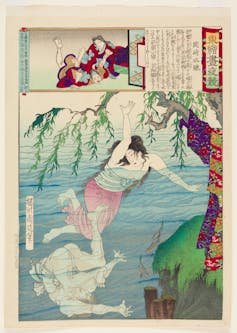
What do we see in a historical painting or photograph that shows a person in open water? Most likely, in the first instance, someone who is engaging with swimming or bathing in a natural environment. But at second glance, these images can teach us many things about a society’s attitudes towards the human body, perceptions of the western and wider world and political supremacy.
For starters, there is the issue of nudity. Artists need to decide about how much of the human body they want to reveal and for what reason. We often think that semi or full public nudity is a modern phenomenon, but there is evidence that during the Middle Ages and the pre-modern period in western Europe, naked bodies were an integral part of society.
The below scene from the late medieval book of hours Les Très Riches Heures du Duc de Berry (The Very Rich Hours of the Duke of Berry), for example, illustrates a party of aristocrats who take no notice when riding past a river where naked people swim and clean themselves.

Due to the nudity and vulnerability of the human body in open waters, sexual encounters and transgression are a theme in many artworks. Take for example Japanese painter Toyohara Chikanobu’s (1838-1912) woodblock print Swimming at Okazaki, No. 16. from the series of prints, Eastern Brocades, Day and Night Compared (1886).

It shows the peasant woman Oai No Kata fending off a male attacker in the water. Interestingly the man – who is dressed in the traditional Japanese fundoshi garment – reveals more flesh than the female swimmer. She is fully dressed, with only her breasts exposed, revealed as a result of the fight.
The woman’s right arm is trying to reach the branch of a tree, which symbolises the dry safety where not only her kimono awaits, but also the established rules and laws that restricted transgressive behaviour.
The pale blue and beautiful water takes on an obscure meaning as a space where sexual misconduct can be hidden more easily than on land.
During the colonial period, western explorers and travellers created artworks showing their version of Indigenous people, both on land and in the water. Belgian engraver Theodor de Bry’s Floridians Crossing Over to the Island Taking Their Pleasures (1591) depicts a group of adults and children from the Timucua tribe, in what today is northern Florida, US, as they cross a body of water.

The transparency of the water is indicated by the faintly showing body parts below the surface. The female swimmers, moving forward by using breaststroke, leave behind ripples of water.
Although the engraver correctly illustrates how the Timucuas wore their hair and ornaments, the image appears strangely appropriated by depicting the human body according to western-European Renaissance standards. The traditional tattoos of the tribe do not feature in the print, possibly because they would have been considered too exotic for the western viewer.
The Sea Gardens, from Stark’s History of and a Guide to the Bahama Islands (1891) by British-American guidebook writer James Henry Stark, meanwhile, illustrates how marine specimen were harvested by black divers for the entertainment of a white crowd.
By using wooden boxes with a glass bottom, spectators were able to watch the underwater scenes. Although this late 19th-century impression depicts a post-slavery society, it still gives clear evidence of power relations with regards to race, revealing fully dressed white spectators who, in a voyeuristic manner, observe the black swimmers for their entertainment.
In many cultures around the world, the ability to swim was and is seen as a trait of masculinity, strength and superiority. In Japan, samurai swimming formed part of a Bushi’s (someone who carried a Japanese sword and fought for a living) training. As the country is an island, being able to swim and fight in the water was an important skill. Images showing battle scenes, especially from the 17th century onward, often show samurai in the water.
Political leaders such as Italy’s Benito Mussolini or China’s Mao Tse-tung linked the physical strength needed to face cold water and dangerous currents with their ability to lead their countries through difficult times. A poem written by Mao in 1956 shows how he used swimming metaphors to endorse his political leadership:
I have just drunk the waters of Changsha
And come to eat the fish of Wuchang.
Now I am swimming across the great Yangtze,
Looking afar to the open sky of Chu.
Let the wind blow and waves beat,
Better far than idly strolling in a courtyard.
The poem reflects on Mao’s first swim in the Yangtze River in 1956, which he did against the counsel of his advisors. The artworks that document the event as an act of political performance were important propaganda tools to validate the communist leader of China.
Photographs from 1966 show how 5,000 people swam with the then 72-year-old leader in the Yangtze, where he stayed in the water for 65 minutes. To increase Mao’s visibility, he was accompanied by a raft that carried his monumental image and placards that asked for 10,000 years of life for him.
To members of the rural community, who were normally not able to swim, the act of “defeating” Eurasia’s longest river must have appeared a true miracle. Mao’s swim performance helped him establish his power during a difficult political period. Less than a month later, on the August 8 1966, the Cultural Revolution was launched.
Kathrin Wagner does not work for, consult, own shares in or receive funding from any company or organisation that would benefit from this article, and has disclosed no relevant affiliations beyond their academic appointment.
This article was originally published on The Conversation. Read the original article.







